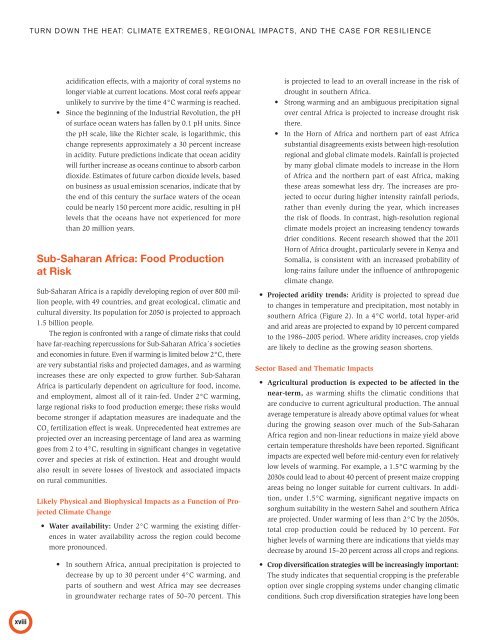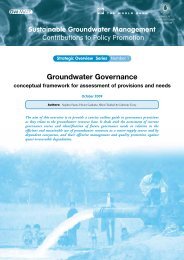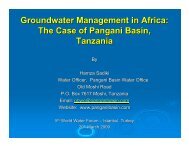You also want an ePaper? Increase the reach of your titles
YUMPU automatically turns print PDFs into web optimized ePapers that Google loves.
TURN DOWN THE HEAT: CLIMATE EXTREMES, REGIONAL IMPACTS, AND THE CASE FOR RESILIENCEacidification effects, with a majority of coral systems nolonger viable at current locations. Most coral reefs appearunlikely to survive by the time 4°C warming is reached. Since the beginning of the Industrial Revolution, the pHof surface ocean waters has fallen by 0.1 pH units. Sincethe pH scale, like the Richter scale, is logarithmic, thischange represents approximately a 30 percent increasein acidity. Future predictions indicate that ocean aciditywill further increase as oceans continue to absorb carbondioxide. Estimates of future carbon dioxide levels, basedon business as usual emission scenarios, indicate that bythe end of this century the surface waters of the oceancould be nearly 150 percent more acidic, resulting in pHlevels that the oceans have not experienced for morethan 20 million years.Sub-Saharan Africa: Food Productionat RiskSub-Saharan Africa is a rapidly developing region of over 800 millionpeople, with 49 countries, and great ecological, climatic andcultural diversity. Its population for 2050 is projected to approach1.5 billion people.The region is confronted with a range of climate risks that couldhave far-reaching repercussions for Sub-Saharan Africa´s societiesand economies in future. Even if warming is limited below 2°C, thereare very substantial risks and projected damages, and as warmingincreases these are only expected to grow further. Sub-SaharanAfrica is particularly dependent on agriculture for food, income,and employment, almost all of it rain-fed. Under 2°C warming,large regional risks to food production emerge; these risks wouldbecome stronger if adaptation measures are inadequate and theCO 2fertilization effect is weak. Unprecedented heat extremes areprojected over an increasing percentage of land area as warminggoes from 2 to 4°C, resulting in significant changes in vegetativecover and species at risk of extinction. <strong>Heat</strong> and drought wouldalso result in severe losses of livestock and associated impactson rural communities.Likely Physical and Biophysical Impacts as a Function of ProjectedClimate Change Water availability: Under 2°C warming the existing differencesin water availability across the region could becomemore pronounced. In southern Africa, annual precipitation is projected todecrease by up to 30 percent under 4°C warming, andparts of southern and west Africa may see decreasesin groundwater recharge rates of 50–70 percent. Thisis projected to lead to an overall increase in the risk ofdrought in southern Africa. Strong warming and an ambiguous precipitation signalover central Africa is projected to increase drought riskthere. In the Horn of Africa and northern part of east Africasubstantial disagreements exists between high-resolutionregional and global climate models. Rainfall is projectedby many global climate models to increase in the Hornof Africa and the northern part of east Africa, makingthese areas somewhat less dry. The increases are projectedto occur during higher intensity rainfall periods,rather than evenly during the year, which increasesthe risk of floods. In contrast, high-resolution regionalclimate models project an increasing tendency towardsdrier conditions. Recent research showed that the 2011Horn of Africa drought, particularly severe in Kenya andSomalia, is consistent with an increased probability oflong-rains failure under the influence of anthropogenicclimate change. Projected aridity trends: Aridity is projected to spread dueto changes in temperature and precipitation, most notably insouthern Africa (Figure 2). In a 4°C world, total hyper-aridand arid areas are projected to expand by 10 percent comparedto the 1986–2005 period. Where aridity increases, crop yieldsare likely to decline as the growing season shortens.Sector Based and Thematic Impacts Agricultural production is expected to be affected in thenear-term, as warming shifts the climatic conditions thatare conducive to current agricultural production. The annualaverage temperature is already above optimal values for wheatduring the growing season over much of the Sub-SaharanAfrica region and non-linear reductions in maize yield abovecertain temperature thresholds have been reported. Significantimpacts are expected well before mid-century even for relativelylow levels of warming. For example, a 1.5°C warming by the2030s could lead to about 40 percent of present maize croppingareas being no longer suitable for current cultivars. In addition,under 1.5°C warming, significant negative impacts onsorghum suitability in the western Sahel and southern Africaare projected. Under warming of less than 2°C by the 2050s,total crop production could be reduced by 10 percent. Forhigher levels of warming there are indications that yields maydecrease by around 15–20 percent across all crops and regions. Crop diversification strategies will be increasingly important:The study indicates that sequential cropping is the preferableoption over single cropping systems under changing climaticconditions. Such crop diversification strategies have long been






